

File:Waste pasttic composite screwless extrusion.pdf - WasteforLife. 3-D Printing of Open Source Appropriate Technologies for Self-Directed Sustainable Development. The technological evolution of the 3-D printer, widespread internet access and inexpensive computing has made a new means of open design capable of accelerating self-directed sustainable development.
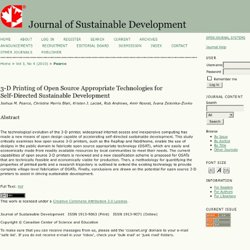
This study critically examines how open source 3-D printers, such as the RepRap and Fab@home, enable the use of designs in the public domain to fabricate open source appropriate technology (OSAT), which are easily and economically made from readily available resources by local communities to meet their needs. The current capabilities of open source 3-D printers is reviewed and a new classification scheme is proposed for OSATs that are technically feasible and economically viable for production. Then, a methodology for quantifying the properties of printed parts and a research trajectory is outlined to extend the existing technology to provide complete village-level fabrication of OSATs. Full Text: PDF This work is licensed under a Creative Commons Attribution 3.0 License . Contour Crafting: Automated Construction: Behrokh Khoshnevis at TEDxOjai.
Landfill Harmonic film teaser. A Lamp which Produces an Electrical Current as a Result of it’s Kinetic Energy. The 3d printed nylon polymer lamp designed by Dr.
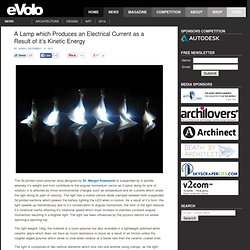
Margot Krasojević is suspended by a spindle whereby it’s weight and form contribute to the angular momentum vector as it spins along its axis of rotation; it is affected by minor environmental changes such as temperature and air currents which rotate the light along its path of velocity. The light has a motion sensor diode clamped between both suspended 3d printed sections which powers the battery lighting the LED when in motion. As a result of it’s form, the light speeds up tremendously due to it’s conservation of angular momentum, the form of the light reduces it’s rotational inertia affecting it’s rotational speed which must increase to maintain constant angular momentum resulting in a brighter light.
The light has been influenced by the physics behind ice skater spinning/a spinning top. 3D-printed ceramic bricks developed for large-scale construction. Nov.1, 2012 After a six-week residency program at the European Ceramic Work Centre in the south of the Netherlands, Brian Peters, co-founder of Amsterdam-based Design Lab Workshop, developed a 3D-printed ceramic bricks project - "Building Bytes".
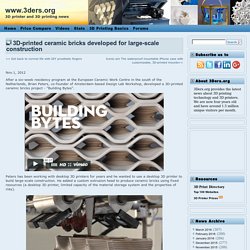
Peters has been working with desktop 3D printers for years and he wanted to use a desktop 3D printer to build large-scale construction. He added a custom extrusion head to produce ceramic bricks using fixed resources (a desktop 3D printer, limited capacity of the material storage system and the properties of clay). This fabrication system, including the materials and technology, allows Building Bytes to be accessible worldwide. The bricks are made from a liquid slip cast recipe of earthenware ceramics, which is typically used for casting molds, while a standard desktop 3D printer is connected to an extrusion system consisting of plastic cartridges and air pressure.
Ribbed brick applications: Columns, Window or Door Openings "X" brick Honeycomb brick. Dutch architect to build "endless" house with 3D printer. Jan.15, 2013 Dutch architect Janjaap Ruijssenaars (39) from Universe Architecture in Amsterdam designed a one-piece building which will be built on a 3D printer.
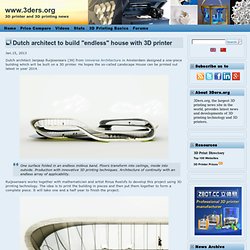
He hopes the so-called Landscape House can be printed out latest in year 2014. One surface folded in an endless möbius band. Floors transform into ceilings, inside into outside. Production with innovative 3D printing techniques. Ruijssenaars works together with mathematician and artist Rinus Roelofs to develop this project using 3D printing technology. (Images: Universe Architecture) Ruijssenaars plans to print every piece in size of 6 x 9 meters using a massive 3D printer called D-Shape.
Ruijssenaars says Dini has suggested to print out the form only. Together with a Dutch construction company, Ruijssenaars is working with Dini to realize the idea. The landscape house is developed for joining Europan, a European competition of ideas for young spatial designers. The landscape house will be a landscape in the landscape. 3d Printing a Brave New World. Imagine if after an earthquake you could airdrop machines that build houses in under a day.
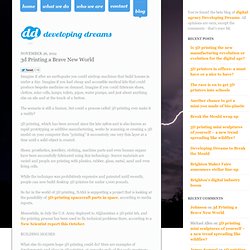
Imagine if you had cheap and accessible medical kits that could produce bespoke medicine on demand. Imagine if you could fabricate shoes, clothes, solar cells, lamps, toilets, pipes, water pumps, and just about anything else on site and at the touch of a button. The scenario is still a fantasy, but could a process called 3D printing ever make it a reality?
3D printing, which has been around since the late 1980s and is also known as rapid prototyping or additive manufacturing, works by scanning or creating a 3D model on your computer then “printing” it successively one very thin layer at a time until a solid object is created. Shoes, prosthetics, jewellery, clothing, machine parts and even human organs have been successfully fabricated using this technology. While the technique was prohibitively expensive and patented until recently, people can now build desktop 3D printers for under 1,000 pounds. Cool new army tire technology.